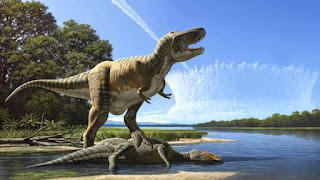The Cretaceous–Paleogene (K–Pg) extinction event, also known as the Cretaceous–Tertiary (K–T) extinction, was a mass extinction of some three-quarters of the plant and animal species on Earth—including all non-avian dinosaurs—that occurred over a geologically short period of time approximately 66 million years ago. With the exception of some ectothermic species in aquatic ecosystems like the leatherback sea turtle and crocodiles, no tetrapods weighing more than 55 pounds (25 kilos) survived. It marked the end of the Cretaceous period and with it, the entire Mesozoic Era, opening the Cenozoic Era that continues today.
In the geologic record, the K–Pg event is marked by a thin layer of sediment called the K–Pg boundary, which can be found throughout the world in marine and terrestrial rocks. The boundary clay shows high levels of the metal iridium, which is rare in the Earth's crust but abundant in asteroids.
As originally proposed in 1980 by a team of scientists led by Luis Alvarez, it is now generally thought that the K–Pg extinction was triggered by a massive comet or asteroid impact 66 million years ago and its catastrophic effects on the global environment, including a lingering impact winter that made it impossible for plants and plankton to carry out photosynthesis. The impact hypothesis, also known as the Alvarez hypothesis, was bolstered by the discovery of the 180-kilometre-wide (112 mi) Chicxulub crater in the Gulf of Mexico in the early 1990s, which provided conclusive evidence that the K–Pg boundary clay represented debris from an asteroid impact. The fact that the extinctions occurred at the same time as the impact provides strong situational evidence that the K–Pg extinction was caused by the asteroid. It was possibly accelerated by the creation of the Deccan Traps. However, some scientists maintain the extinction was caused or exacerbated by other factors, such as volcanic eruptions, climate change, or sea level change, separately or together.
A wide range of species perished in the K–Pg extinction. The most well-known victims are the non-avian dinosaurs. However, the extinction also destroyed a plethora of other terrestrial organisms, including certain mammals, pterosaurs, birds, lizards, insects, and plants. In the oceans, the K–Pg extinction killed off plesiosaurs and the giant marine lizards (Mosasauridae) and devastated fish, sharks, mollusks (especially ammonites, which became extinct) and many species of plankton. It is estimated that 75% or more of all species on Earth vanished. Yet the devastation caused by the extinction also provided evolutionary opportunities. In the wake of the extinction, many groups underwent remarkable adaptive radiations—a sudden and prolific divergence into new forms and species within the disrupted and emptied ecological niches resulting from the event. Mammals in particular diversified in the Paleogene, producing new forms such as horses, whales, bats, and primates. Birds, fish and perhaps lizards also radiated.
Explanation from: https://en.wikipedia.org/wiki/Cretaceous%E2%80%93Paleogene_extinction_event











I tend to agree with the analysis of events as featured above.
ReplyDelete⚛☤🗺 Evolution 🗺☤⚛
ReplyDeleteEvolution
ReplyDelete... E nós evoluímos realmente ???
ReplyDeleteSpeculatii si atit
ReplyDeleteThis comment has been removed by the author.
ReplyDeleteCould it all happen again ?
ReplyDeleteAgreed with the article above..
ReplyDelete